ow! is excited to have the opportunity to sit down and chat with the very busy and incredibly talented, SANDI AULT. Her first novel, WILD INDIGO, won a special Edgar—the Mary Higgins Clark Award—and it was the first time a debut novel had ever been nominated for the award. WILD INDIGO was also nominated for Best First Mystery Novel by the Mountains and Plains Independent Booksellers Association. This exciting debut in the WILD Mystery Series made nine regional bestsellers lists and received acclaim in reviews across the nation, including The New York Times.
Ault received two starred reviews each (Publishers Weekly and Library Journal) for WILD INDIGO and WILD INFERNO, the second in the series. WILD INFERNO was named one of the Best Books of 2008 by Publishers Weekly, and it, too, met with critical acclaim from the national media, who compare Ault’s work to that of Tony Hillerman, J. A. Jance, and Nevada Barr.
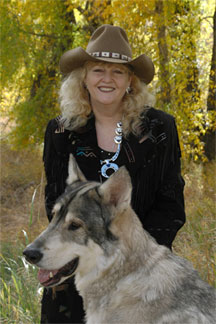
Ms. Ault teaches WILD Writing Workshops, and frequently speaks on the issues of wilderness, wolves, writing, and many aspects of Indian Country, among other topics. She has served as keynote speaker for the National Endowment for the Arts’ Big Read Program.
Ault lives with her husband Tracy, her wolf Tiwa, and her Missouri wildcat, Buckskin in the Rocky Mountains of Colorado, where—in addition to writing novels—she has until recently served as a volunteer firefighter as well as a Fire Information Officer responding locally and nationally to wildfires. The Aults travel extensively including annual field research on ruins, petroglyphs, native culture, and wilderness. Their photographs of ruins, petroglyphs and wolves have appeared in numerous publications.
Photo: (Sandi with her wolf Tiwa) by Tracy A. Kerns ©2009
I was able to speak with Sandi on the topics WOW! readers are most interested in, such as editing, self-promotion, and belief in our writing abilities. But I also got Sandi to open up about causes close to her heart, including the protection of wild wolves. And, of course, Sandi chatted with me about the WILD mystery book series, including the newest release, WILD SORROW—a touching and heart-wrenching story filled with the usual action, suspense and adventure of Jamaica WILD. Grab yourself a cup of your favorite thirst-quencher, pull up to your computer screen and get comfy as we jump right into an insightful chat with SANDI AULT.
WOW: Sandi, welcome to WOW! Thank you so much for squeezing some time into your very busy schedule to chat with us. Let’s get right to it…what were you like as a child? I see you as one of those imaginative, curious kids who always had animals following her home.
SANDI: Actually, I was a service brat. We moved almost annually, and I have lived all over the world. We sometimes had family pets, but all our moving made that difficult. I was a cowgirl as a child, always strapping on two six-shooters and wearing a black cowgirl hat. I fell in love with the West from the beginning. I was always outside, whatever the weather, unless I was reading a book!
WOW: I can just see you as a little cowgirl! (Laughs) My mom was a huge John Wayne fan so I totally understand your love for the West. You mentioned your love for books even as a girl. What sparked your passion for writing?
SANDI: Because we moved so often, the first friend I usually made anyplace new was the librarian! I felt more at home at the library than most anyplace else. I have always loved to read, and I started writing as soon as I could hold a pencil. I think it was a calling with me, not so much a choice!
WOW: That’s beautiful. Now you were an editor earlier in your career. What were some common mistakes you saw writers make and what suggestions do you have to avoid them?
SANDI: I was a section editor for The Kansas City View. In journalism, the worst mistake is taking too long to get to the point, the crux, the crisis of the story. It usually has to be set out in the first line as a hook, or in the headline. I don’t think that’s a bad idea for most writing. If a writer doesn’t want to set out the crux in the first section of the work, she should at least allude to it. In fiction, I believe that the worst thing a writer can do is work too much in passive voice. And it is a very common mistake.
WOW: I hear you. Passive voice is an Achilles’ Heel for a lot of writers. Thank you for that insight. Sandi, I was excited to find out that you teach WILD Writing Workshops. Can you tell us a little bit about them?
SANDI: A WILD Writing Workshop is a place where a writer can come and learn a set of skills that will cause her work to improve right inside the time frame in which the workshop is held. That means that if you come to my workshop in the morning, by the afternoon, you will demonstrate (and everyone else there will see) that you have grown as a writer, and you will be able to use the craftsmanship I have taught you immediately. I focus mainly on a core set of basic skills that strengthen the writer’s voice and bring vitality and mastery to the writer’s own work. I offer fun handouts the writers use right in the workshop to learn and practice, I always do writing games that not only provide laughs, but also offer the opportunity to exercise creativity in response to a challenge.
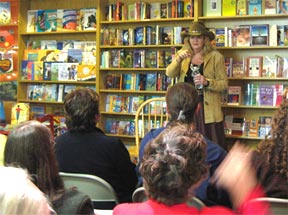
I love to teach, and many of my former writing students are now published authors, and I think I might have had a bit to do with that.
Photo: Sandi teaches a WILD Writers Workshop at The Well Red Coyote, Sedona, Arizona
If you imagine that you have been wandering as a writer, perhaps in the desert, exhausted, dehydrated, hungry…without whatever energy and knowledge of the lay of the land that you need to go any farther, then a WILD Writers Workshop is like an oasis where you will find new direction, nourishment, water, maps, a compass, and companions to accompany you as you travel on. And while you are at “the oasis” (that is the workshop itself), you will be entertained, amused, fortified, and find excitement, fun, laughter, and new confidence!
(Editor’s Note: For information about Sandi’s latest WILD Workshops, visit her Appearances Page.)
WOW: I love the analogy of what your workshops offer—makes me wish I lived closer! Let’s talk a bit about your other passion: nature. Next to my own mother and, maybe, Steve Irwin, I don’t think I’ve ever seen another person more passionate and compassionate about nature than you are. Where did that love for the environment and animals sprout from?
SANDI: I have always loved animals and the outdoors. My grandfather, who was one-quarter Cherokee, could “talk with” the animals. He fed squirrels, raccoons, birds, and even deer right out of his hands. He knew everything about navigation across the landscape, especially forestland. But, far and away, my greatest teacher was my first wolf companion, Mountain, who truly taught me how to live. I live “wilder” than most because I share life with a wolf, and Mountain was the one who taught me to live next to and love our Mother Earth the way I do now.
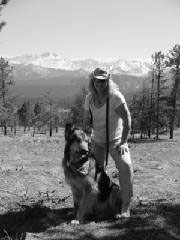
The character of Mountain in the WILD Mystery Series is based on the real wolf who came into my life and changed it forever. Readers might enjoy the story of how Mountain came to live with us, and the exciting and life-changing experience his last summer was for us, when we took him high into the mountains and wandered free and lived off the land so that he could return to the wild one last time. You can visit https://sandiault.com/id4.html to see photos of Mountain and read the story about him.
Photo: Sandi with Mountain in the Rockies.
WOW: I loved Mountain (and we’ll talk a bit more about him later!) And I do hope our readers check out the photos and pictures—they’re beautiful. You and I share something in common: A deep respect for the Native American/Canadian culture. Can you share a bit about your deep-rooted interest in this culture and the extensive research you’ve conducted on it? Have you had the opportunity to spend time with them?
SANDI: The WILD Mystery Series mainly features the Native Puebloans of the Southwest. But I have always been fascinated by Native America. From the time I was small, I read everything I could get my hands on about American Indians and their customs and history. I used to make medicine bags when I was very young, even for my teddy bears and all my friends and family members. I studied with a Lakotah shaman named Red Crow for some time, and also learned to make medicine bundles from a woman named Sweetwater Basket. As I said, my grandfather was one-quarter Cherokee, and that has had a powerful influence on me.
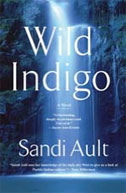
The story in WILD INDIGO of how Jamaica meets Momma Anna and becomes a part of her family by adoption is pretty much true of what happened to me with the Puebloans. When my husband and I were married, we were adopted by a Tiwa family in New Mexico at one of the pueblos, and we now have a huge extended family there. I am considered a daughter of the tribe, and my husband a son, uncle, and father of the Tiwa clan we have been adopted into. It is a precious and amazing gift.
You mentioned Canadian culture, which I might add, has a rich diversity of First Nations I have yet to fully explore. But my husband keeps an office and a team of folks working for him in the Seattle area, and we have begun to explore the Canadian First Nation cultures of British Columbia and the islands off the West Coast of Canada and Washington State, and I am thoroughly fascinated. I think my sleuth Jamaica might have to go to the Northwest sometime to solve a murder mystery among the seafaring First Nations there!
Finally, about the research aspect: I always tell folks that I research as if I were writing non-fiction so that I can have the highest level of credibility in my work that is possible within the time constraints of writing a book a year, which is per my contract. I have a research assistant who also helps me with this, but I write a story that is so deeply steeped in fact and real landscape and culture that it is full of truth even though it is fiction.
WOW: Yes, you can definitely feel that depth in your words. I often felt as though I were right there with Jamaica and Mountain…seeing the landscape, smelling the cold mountain air. And, can I say, “YAY!” that Jamaica may have a mystery to solve up North with the First Nations. (Laughs) Seriously, that would be awesome and I know they’d be honored. Now, let’s delve right into WILD Sorrow. The subject matter in this book—the treatment of the Native Americans in the Indian Boarding Schools—is a sensitive and very emotional one. You handled it beautifully. Were you worried at all that it wouldn’t sit well with some of your readers?
SANDI: No. I felt called to write this book, as if the Great Spirit wanted someone to look at this from the outside, compassionately, and just write what she saw. I felt chosen to do this, if you can believe that.
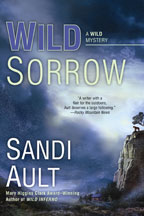
My greatest concern when I write a book is not what my readers will think, because if I honor the storyteller skills that Creator has given me, if I hone my work and seek to always improve my level of craft, then whatever I write will be a gift to the world made from the gifts that have been given to me. But I do feel concern always for how I express what I see of Native culture. The Tiwa culture is strictly an oral culture (storytelling), and is not a written one nor is it a written language. They are extremely guarded about that, and do not wish to share their culture with outsiders in most respects. So I am as careful as I can possibly be to describe an authentic picture of the culture without divulging sensitive information. This means that I have to sometimes change the details of rituals, or invent similar ones so that I can give the impression of the culture without defining it exactly. I do this out of respect for my Tiwa family and friends.
WILD SORROW was a book that came out of my heart. It was a very cathartic experience, and I feel it is my best work yet. I managed, somehow, to get out of the way of the story and just let it come through me. The plot is woven from a complex and delicious set of circumstances: the plight of the mountain lion and her family echoes the plight of the West in the face of encroaching development and unrestricted use. The plight of the Native Americans with respect to the Indian Boarding Schools echoes the strength and dignity of the People, but also the fragility of the last few strongholds of living Native culture in this country. And the emotional evolution of all the characters in the story (even Jamaica’s relationship with Mountain) portrays some of the necessary passages of a life fully lived.
I am fiercely proud of this novel, and I felt great love for the story. I think it comes through on the page.
We have a special website just for WILD SORROW at www.wildsorrow.info
WOW: First of all, having read the book—and only taking about three days to finish it—I agree you may have been chosen to write it. And it’s beautiful to see the lengths you went through to respect the culture of the Tiwa. The reader got enough information to form a mental picture and understanding. I personally felt the emotion element from the first page. Another awesome thing about your book, that I never even realized until I’d finished reading it, was how different it was from most other suspense/thriller/mysteries I’d read: no explosions or loud car chases/crashes, no explicit and bloody fighting scenes and not one curse word.
WILD Sorrow contains all of the elements a mystery/suspense needs but without the need for “Hollywood-izing.” Was that your intent so all age groups could enjoy your books?
SANDI: I hope that young women will read my books. I don’t aim for that audience (I don’t particularly aim for any audience, actually. The stories just come through me.) But I truly hope that young women can enjoy them, because I think Jamaica is a really wonderful role model of strength, dignity, and a life lived authentically. She is complex, sometimes troubled (as all real people are), and yet passionate and full of adventure. She’s not a cardboard-cut-out heroine with a super-powers-suit. She’s a real person. She gets hurt. She gets scared. She gets knocked down and has plenty of danger. But she’s got a core strength and a passion for what she believes in that drives her on in spite of it. I adore her, and most readers do, too.
“Any time you have a mistake in the ‘facts’ of a story, the reader emerges from the fictive dream, and you have lost him or her.”
WOW: I totally agree. And those were the exact thoughts I had while I read the book. We touched earlier on the extensive research you conduct for your books and how it was especially important for WILD Sorrow. How important is it to do thorough research, even if you know a subject deeply?
SANDI: As I said, I research as if I were writing non-fiction. I think all the knowledge I continue to acquire deepens the credibility and authenticity of my work. I think a writer who knows her subject from A to Z gives the reader a sense of confidence, of being in “good hands” so that the reader can relax, let go, and sink into the story, the fictive dream. Any time you have a mistake in the “facts” of a story, the reader emerges from the fictive dream, and you have lost him or her.
It’s impossible to get your credibility back once you’ve done that. So research is very important to me. And I love it. For every book, I take a lengthy field expedition before I write a word, to explore and get to know the setting, which for my books is generally way out in the backcountry. I hang there until I know what it feels like, everything I can know about it. I film it, I shoot photos, I take notes, I read everything about it I can find, and I talk to the people who live there (if people live there) or study the wildlife. After I have written a draft, I go back to check my facts. This means at least two months of field research per year because I write a book a year, even while touring and promoting the previous release. And I read, read, read, read, read. Everything I can find about my subject matter.
For WILD SORROW, I interviewed fourteen elders who were survivors of Indian Boarding Schools. In some cases, this meant going to the reservation and visiting the elders several times until they were willing to talk with me about their experiences. I find with Native cultures, there is a reluctance to share with outsiders until they know you a while. So, for any story, I generally have to go hang around until I have become familiar with the indigenous people. It sometimes takes a lot of time in which it seems like I’m not gathering any information at all. But ultimately, I come back home with all my notes and photos and film and find that I have soaked up a sense of place and culture while I felt like I was doing nothing but waiting until some of the local Indians were willing to talk with me.
“As a wildland firefighter and a volunteer firefighter in my small mountain community, I’ve seen a lot of death, and done a lot of rescues.”
WOW: It must have been a phenomenal experience spending time with the Elders—both emotionally and spiritually. I envy you. WILD Sorrow is the third book in the very successful series. How do you know when a story can continue on? How do you keep the characters and story lines fresh in each book?
SANDI: This sounds strange, but my characters hang out at my cabin in the mountains with me when it’s time to do another story. They have things they want to tell me. They wake me up at night and bother me until I get up and write what they have to say. My cabin is really tiny, so it gets pretty crowded around here at times. The best thing for me is to get still, sit in front of the computer, and “listen” to them. They start telling me what is going on in their world, and I start writing it. Jamaica and I live kind of similar lives: we both live with a wolf in a remote cabin almost off the grid.
We both spend almost all our time outdoors, and we both end up seeing a lot of death and danger. As a wildland firefighter and a volunteer firefighter in my small mountain community, I’ve seen a lot of death, and done a lot of rescues. People drive off the cliffs here because they take the mountain curves too fast and we have to rappel down and pull them out of the river, which is frequently frozen. People drive their ATVs into trees and either kill or severely injure themselves. People wander too far into the backcountry and get lost and we have to do a search and rescue. People freeze to death in the winter, thinking they can explore the mountains without adequate gear and skills. People fall off of rock faces trying to climb them, run into bears, deer, elk, and even mountain lions in their cars, and then there are wildfires. And an occasional plane or helicopter crash.
It’s pretty easy to come up with a new scenario for Jamaica with all that kind of stuff going on! And I visit my Tiwa family four or five times a year at the pueblos. There is always some big thing going on there. They live on the knife-edge of extinction, and their way of life is always threatened. I can always find a great new story when I visit. My problem is finding enough time to write everything down!
WOW: WOW, Sandi! What an amazing life you (and Jamaica) have. While we’re on the subject of Jamaica, what I loved the most was her raw “outdoorsy” style and her fantastic ability to adapt. For example, when her power was off for the longest time but we saw how she still cooked her meals, built an old-fashioned shower and other “back to the old days” approaches. She never complained or went to a Hilton (like a lot of us would have) she just…became one with nature. She’s also strong, intelligent and resourceful. A strong modern woman character! Where did she come from? I know we touched on this earlier but some of us would say she’s Sandi in print!
SANDI: I have to confess…I’ve done most of what Jamaica has done because, as I said, we live very similar lives. You can’t just go to a hotel with a wolf. It’s important to be resourceful enough to live in the backcountry if you’re going to have a home there. I have learned a particular set of skills that allow me to survive being snowed in, without power, without water, etc. because I live in an environment where all that is common enough! But I wouldn’t live anywhere else. Mountain taught me how to live, what was really important, where I needed to be to have the most authentic and meaningful life for me.
When I had to go to New York City for the Edgar Awards (WILD INDIGO won the Mary Higgins Clark Award in 2008), I was afraid how I would do without being able to see for about a hundred miles in every direction and get under a tree for shelter. I’ve gone a little WILD since I took up living with wolves! I tour the big cities, but it’s always good to get home!
WOW: That’s awesome and very inspiring. Many of us wouldn’t have the same survival “know-how” in the same situations. How many more adventures can we look forward to seeing Jamaica in? Or will you be trying out something new?
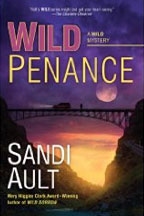
SANDI: WILD PENANCE is already in editorial process, and I’ve seen the fabulous new cover art for it! This book releases February, 2010. It’s a prequel (a la STAR WARS) where we go back in time to where Jamaica and the other characters in the series first met. I love the story so much, and I know readers will, too. The murder in WILD PENANCE surrounds the secret brotherhood called The Penitentes, who practice ritual flagellation (and until very recently, also ritual crucifixion) in the remote, high mountain villages of New Mexico. It’s a thrilling story!
I have plans for more WILD Mysteries, and I have also been asked to do some other projects recently. One publisher requested a children’s book about wolves. And I have done research already for another book, which I’ll keep a secret until I’m a little farther along. I would love to be able to write two books this year!
WOW: I can’t wait until WILD PENANCE comes out. And what a great idea about the children’s picture book! I know my daughters would love that. I couldn’t help but notice that Jamaica has a very handsome sidekick. Did you want to talk about him and his importance to the series?
SANDI: Kerry Reed, the forest ranger boyfriend in the series, is swooningly based on my own handsome husband. In WILD INFERNO, I gave Kerry a chance to come forward a little more and demonstrate a bit of the complexity in his character, which stems mostly from his experiences as an Army Ranger in Somalia. It was great to get a chance to feature him more in that book, because in WILD INDIGO, (the first in the series), I had to introduce so many new characters that I had to choose which ones I could depict in detail. I chose to focus on Jamaica’s relationship with Momma Anna, the old pueblo woman, in INDIGO because I thought it was important to fully steep the reader in the Puebloan culture, which is where Jamaica worked. And Mountain needed his own introduction and focus because he is Jamaica’s sidekick. But in INFERNO, I put Jamaica and Kerry on a wildfire away from the pueblo so that I could really highlight more of who Kerry is, at base. I adore him. The more I get to know him, the more I like him.
WOW: I like him too and it was nice to see the softer, romantic side of Jamaica. Sandi, your descriptions of people, places and events are so vivid I felt I was right there with Jamaica and Mountain. But it wasn’t congestive, as it can be in some books. That’s a phenomenal skill. Do you have any tips on scene creation/description for our authors-in-waiting?
SANDI: This is tricky. Elmore Leonard would tell you never to describe the landscape, but then he’s a very different writer than I am. My favorite writer, bar none, is James Lee Burke, and he describes things so well that I can feel the humidity in southern Louisiana and smell the detritus in the swamps. I love that. I guess because I traveled so much as a child, I like to “go someplace” in a book and really “be there.” The readers who share that desire will love my work, I think. It has been described over and over again as “filmic.” I agree. I have always loved film, and so I love to set the scene such that you feel like you are watching a movie as the story unfolds.
And speaking of film, we keep having nibbles about film for the WILD Mystery Series. Nothing has fully transpired yet, but several production companies have approached us about WILD INDIGO! I would love to see Jamaica on screen. I picture Charlize Theron playing her.
“I selected thirty-one agents, sent the query letter with the first chapter of WILD INDIGO, and then watched in amazement as the phone began to ring off the hook almost immediately.”
WOW: Oh, Charlize would be a perfect Jamaica! You seem to have the self-promotion and marketing areas covered. Did you work hard to get yourself and your work out there before your book came out or did most of the self-marketing occur after? Or is equally important to do both?
SANDI: This might be a great time to tell you how the WILD Mystery Series got sold. I wrote WILD INDIGO completely, finished the manuscript, and then wrote a killer query letter. I did my research, locating agents I thought would like to represent a mystery that lands more on the literary side of the genre than not. Based on their previous sales, the folks they represented, and their status in the marketplace, I selected thirty-one agents, sent the query letter with the first chapter of WILD INDIGO, and then watched in amazement as the phone began to ring off the hook almost immediately. Thirty of the thirty-one agents asked to see the manuscript. That rang up a hefty tab at Kinko’s, let me tell you! And the post office as well!
Of the thirty who looked at the manuscript, twenty-nine offered to represent it, and the other one didn’t get around to reading it in time before I made my decision. I interviewed all the agents by phone, sending them a list of questions, and getting to know them with a long phone conversation and their answers. And then I selected my agent from that pool, because she was my first choice after I’d gotten all their answers and we’d chatted a bit. But it was a hard choice. I had a strong second and third choice and had a tough time making up my mind.
In the end, we submitted the book to twelve publishers, and quite a few of them wanted to buy it. The book went to auction, the publishers bid against one another, and Berkley Prime Crime bought the series for the highest price. As a result, they promoted WILD INDIGO with a lot of fanfare and a lot of support.
I did not need to do my own self-promotion, however I chose to add whatever I could to what Berkley was doing. I decided to work with independent booksellers, to send them information about the book and to try to get to know them. I hired an assistant, and away we went!
Since then, I have done a number of things to continue to help promote the series, but most of it is centered around the independent booksellers, whom I adore. The fan base has started to take on a life of its own with my WILD Bunch, and I now have fans writing about the series, the books, and doing guest blogs and WILD Beat Reports on my website, which is huge fun for me! It’s a wonderful, WILD community. Your readers can see what the WILD Bunch is doing by visiting https://sandiault.com/id34.html.
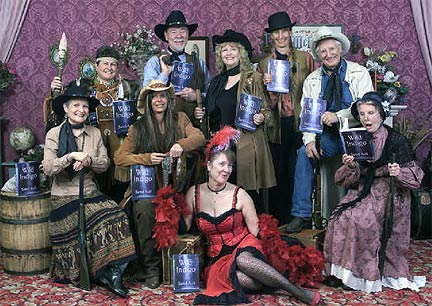 Photo above: Sandi with some of the WILD Bunch members. Visit the link above to find out more!
Photo above: Sandi with some of the WILD Bunch members. Visit the link above to find out more!I love to promote my work, and I think I’m just naturally good at it because I like people, I love my fans so much, I love my series, and I especially love booksellers and librarians. But I am truly not sure that I have done anything that has greatly impacted the sales of my books, and I think it’s important for your readers to know that. What I have worked to do is to get some recognition with the independent booksellers, who are the rock stars of the publishing world, as far as I’m concerned. They have done all the work to get my books into the hands of readers. They had to know about my books in order to promote them to their customers, so I think the work I did there may have helped me stand out a little from the pack with the booksellers.
And Berkley has given me wonderful tours, interviews, and gotten the books great reviews from the likes of The New York Times and The Washington Post and others, so they have probably done the most for my series and my career.
“The best and most self-promoting thing a writer can do is become a better writer.”
WOW: Excuse me for a moment…I have to write that all down. (Laughs) What an incredibly inspiring story about all of the agents wanting your series! I think an important element to make note of is making a “killer query letter” then researching agents suited best to our work. Now, as a promotion “pro,” what are some things our authors and authors-in-waiting should be doing to help get their books into as many hands as possible?
SANDI: I would caution any author to focus mainly on her craft. I always have a few aspiring authors at every signing who ask for guidance on attaining success. I don’t think the answer is in promotion. I think the answer is in the story. The world needs great storytellers. The world will always want good stories. This is how our culture is conveyed. I would encourage every aspiring author to work, work, work, work, work on her story, her craft, her skills, and then let the story find its way into the world.
Once it is born, like a newborn child, the author will find ways to nurture the new life and support it. It is fun to think of creative ways to do this, ways to brand your image and convey the most authenticity about you and your work with the most immediacy. But none of this will work if the story isn’t great. The best and most self-promoting thing a writer can do is become a better writer.
WOW: Awesome advice. Let’s talk awards: WILD Inferno, “One of Best Books in 2008” by Publishers Weekly’ sold out in just five days; WILD Indigo won the “Mary Higgins Clark” award (1st ever debut novel nominated for this prize); sold out in seven days; named one of the 100 most popular books of 2007 by AllBookStores.com; made it onto nine bestseller lists; and the list goes on and on. You’ve even been compared to the works of Tony Hillerman, J.A. Jance and Nevada Barr. Amazing! And you seem to take it all in stride. How does all of that recognition feel and what do you do to stay grounded?
SANDI: Yes, this has been an amazing start as an author. WILD INFERNO made five best Books of 2008 lists, and was the only book (of any kind) that made both the prestigious Library Journal and Publishers Weekly Best Books list. It was also recently named a finalist for the Colorado Book Awards by the Colorado Center for the Humanities. And I have already mentioned how WILD INDIGO won the special Edgar Award named for the great Mary Higgins Clark (who presented the award to me herself!) I was honored to get great blurbs for my first book from Tony Hillerman and C.J. Box, two incredible authors and many-times-over award winners and major bestsellers.
The recognition feels nice, but this is the truth, honestly: what really matters most is that I hear from readers that the books have stirred them, have touched their souls, have even changed their lives. I gotone email to our website recently titled “Sandi is my Sanity” from a new mother who had a challenged life and escaped into the WILD Mystery Series and it made her rethink where she was going and what she really wanted to do next. I can’t tell you how much that moved me.
I’m pretty down to earth, as you might imagine. It’s not hard to stay grounded when you have to stack your own firewood and try to invent new and resourceful ways to keep bears from getting into your house and elk from eating the herbs you planted for your salads. And living with a wolf will bring you right down to reality fast!
WOW: (Laughs) I would say so! And I loved the story about the new mom…so touching. I’ll bet you get a lot of fan mail like that because you elicit such tremendous emotion in people. Tell us all about “WILD Things,” how it came about and its purpose.
SANDI: We have a WILD Things page on our website at https://sandiault.com/id25.html, which highlights some of the incredible encounters with wildlife I’ve had while doing research in the backcountry. It also leads readers to places where they can support the preservation of wilderness and wildlife, sites for Defenders of Wildlife and the Wolf Education and Research Center, and so on.
We also offer our own line of WILD Things on our website and on our online Zazzle Store.
These cool items with the GO WILD logo on them are for friends and fans who want to have treasures from the WILD Series for their own fun and pleasure. Our WILD Web Wizard and Graphics Guy, Eric, designed them. I love them, and I usually give these items as gifts. Everyone loves them! I just saw a woman the other day walking down the street with a black GO WILD tank top on, and I smiled quietly to myself! The WILD Bunch members earn points to get WILD Things by helping to spread the word about the WILD Mystery Series. Folks can sign up for the WILD Bunch on the WILD Bunch Mesa page on our website at https://sandiault.com/id34.html
WOW: I loved browsing through everything. Sandi, your love for wolves is so touching. Can you tell our readers a little bit about Wolf Education and Research Center (WERC)? I think what they do there, and what you’re doing to raise awareness, is so important.
SANDI: I visited the last remaining members of the legendary Sawtooth Pack at WERC in Winchester, Idaho, some time ago. Since then, one member of the pack has passed beyond the ridge, and the center has rescued and adopted the Owyhee Pack. This facility, hosted by the Nez Perce on their reservation, is an excellent organization, and I support them personally and professionally. They work hard to maintain a dialogue about the preservation of wolves with the opposition, which is mainly the hunting lobby. They provide educational outreach about wolves, and they shelter wolves, and provide a means for us to study and better understand wolf behavior and pack culture. It’s an excellent organization.
WERC is in dire need of funding help during this economic downturn. I encourage readers to visit their website at https://www.wolfcenter.org/ to learn more, and to perhaps give a little (no amount is too small) to help this center and these wolf packs survive. We support WERC at sandiault.com. Another excellent organization which I also support is Wolf Haven, International in Tenino, WA.
WOW: Thank you for all of that information. I hope our readers take the time to check it out and learn about wolves. Okay, I have to ask about your experience as a Fire Information Officer and as a volunteer firefighter. Do you have any experiences that stand out in your mind—acts of courage or inspiration—that really stayed with you?
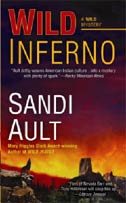
SANDI: The firefighters in my little mountain community department are the most courageous and heroic men and women I have ever known. They have risked their own lives time and again to save others. We do lots and lots of mountain rescues, motor vehicle rescues, medical rescues, and we also fight wildfires. The sense of devotion and heroism that embodies my fellow firefighters is a source of constant amazement to me. I have mentioned a few of the kinds of things we have done together previously in this interview, but suffice to say, I am smitten by these guys with whom I have been honored and privileged to serve.
I write about my experience as a wildland firefighter and Fire Information Officer in WILD INFERNO, and I think I got it right. It’s an exciting, dangerous, immediate, fast-paced, adrenaline-driven world with its own culture and heroes. I love that I could bring Jamaica and Mountain onto a wildfire and depict what I have loved doing for so many years in one of my stories! I encourage folks who are interested to check out the WILD INFERNO page.
“If you feel called to write, you have a story the world needs to hear.”
WOW: Your work as a volunteer wildland firefighter just shows another example of your passion for nature. I admire you. For our final question, we’d love you to share any final thoughts and/or pearls of wisdom.
SANDI: Because this is for WOW!, I want to encourage your writer/readers to believe in themselves and in the stories they feel compelled to tell. If you are facing difficulty or obstacles, if you are not finding the path to success immediately, don’t be discouraged. I once sold a book and before it came out in print, the editor had a heart attack, and the book never saw the light of day. I wanted to put my head in the oven! I had told everyone I was about to be a published author, and the book never came out! But I persisted (thanks to a lot of encouragement from loved ones, and especially my hunky husband). I wrote another book, but that one did not appeal to anyone because they couldn’t figure out how to sell it.
It was the THIRD book I wrote, WILD INDIGO, that had HUGE success and went easily into the marketplace. So, if I’d given up, if I’d just read the external signs, I would never have succeeded.
You have to trust your internal signs more than whatever is coming in from “out there.” If you feel called to write, you have a story the world needs to hear. Focus on that over what the world is telling you. Keep writing! Keep polishing your craft. Keep building your inventory. Your finished works (books, essays, magazine articles, whatever) are like aces in your hand at a poker game. The more you have of them, the better chances you have to win.
The real kicker in my story? That first book that never came out? I retained the rights because the publisher never published it. I sold it a second time, and it will be out in February of 2010. That book is the next WILD Mystery: WILD PENANCE!
WOW: What a truly inspiring story, Sandi. Thank you for sharing it. I enjoyed our time together and hope your wonderful words spark some encouragement in our WOW! readers. We’ve appreciated your openness, generosity and wisdom.
For more information about Sandi and her upcoming events, please visit: www.SandiAult.com and www.WildSorrow.info
CHYNNA TAMARA LAIRD is a psychology student, freelance writer and author living in Edmonton, Alberta with her three daughters [Jaimie (six), Jordhan (four), and baby Sophie (one)] and baby boy, Xander (two and a half). Her passion is helping children and families living with Sensory Processing Disorder and other special needs.
You’ll find her work in many online and in-print parenting, inspirational, Christian and writing publications in Canada, United States, Australia, and Britain. She’s most proud of her children’s picture book, I'm Not Weird, I Have SPD, which she wrote for Jaimie. In addition, she’ll have a memoir about raising a child with SPD out in August of 2009 and a reference book about the Sensory Diet coming January 2011.
Please visit Chynna’s website at www.lilywolfwords.ca to get a feel for her work and what inspires her.